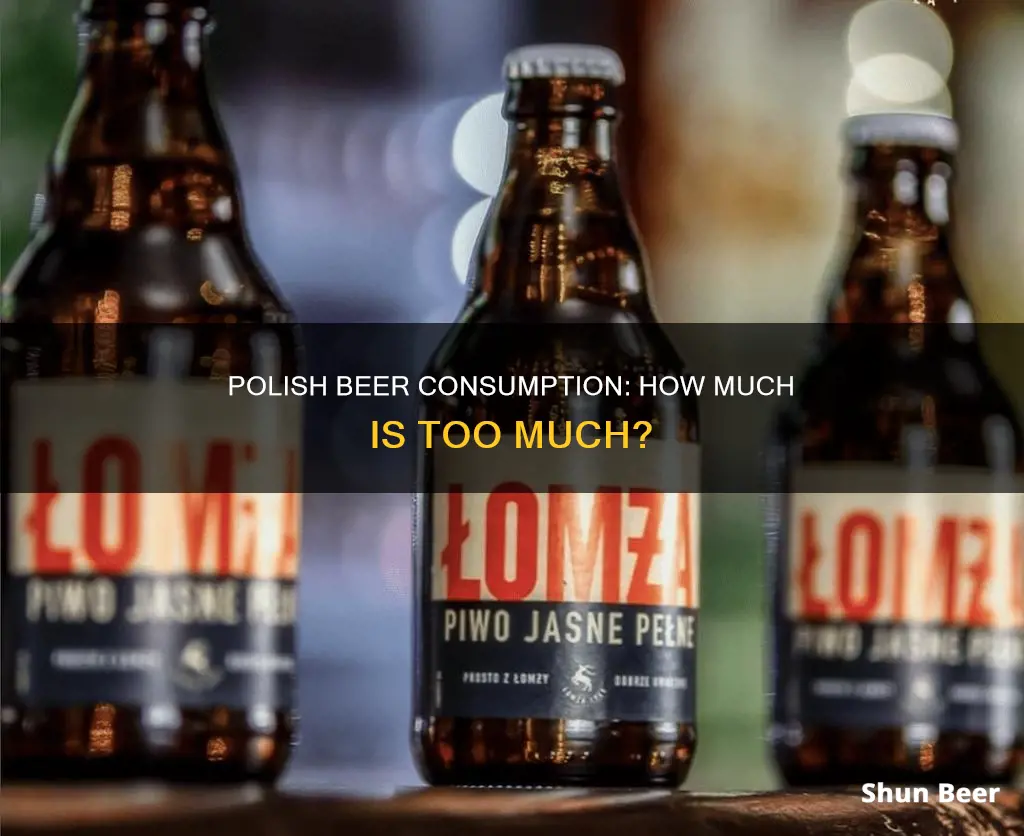
Alcohol consumption in Poland has been a topic of interest for many. While some stereotypes portray Poles as heavy drinkers, the reality is more nuanced. According to the World Health Organisation, Poland is in the top 10 countries for alcohol consumption in Europe, but it ranks below neighbouring countries like Lithuania and the Czech Republic.
Over the years, Poland has witnessed a steady increase in alcohol consumption, even as the general trend in Europe moves in the opposite direction. Beer is the most popular drink among Poles, with over half of the surveyed population consuming it. Vodka, often considered Poland's national drink, is consumed by 39% of the population, while only 7.6% choose wine.
When it comes to drinking culture, Polish people typically consume vodka in shots rather than mixing it with other drinks. It is also common to have a chaser, such as juice or soda, after a shot of vodka. Alternatively, some prefer the old-school approach of having a pickle to snack on instead of a beverage.
While the perception of Poles as heavy drinkers may be exaggerated, it is worth noting that alcohol consumption in Poland has been on the rise. In 2019, Poles consumed an average of 9.78 litres of pure alcohol per person, setting a new record. This represents a 50% increase since record-keeping began in 1993.
However, it's important to remember that drinking habits can vary within the country, and not all Poles drink heavily. Some individuals and regions may have different cultural norms and attitudes towards alcohol consumption.
| Characteristics | Values |
|---|---|
| Average alcohol consumption per capita (2019) | 9.78 litres of pure alcohol |
| Average beer consumption per capita (2019) | 97.1 litres |
| Average wine consumption per capita (2019) | 6.2 litres |
| Average spirits consumption per capita (2019) | 3.7 litres of pure alcohol |
| Average alcohol consumption per capita (2016) | 9.7 litres of pure alcohol |
| Average beer consumption per capita (2018) | 100.5 litres |
| Average spirits consumption per capita (2018) | 3.3 litres of pure alcohol |
| Average wine consumption per capita (2018) | 6.0 litres |
| Average alcohol consumption per capita (1993) | 6.52 litres of pure alcohol |
| Average alcohol consumption rank in Europe (2016) | 3rd |
| Average alcohol consumption rank in the world (2016) | 10th |
What You'll Learn

Beer is the most popular alcoholic drink in Poland
The tradition of brewing in Poland dates back to medieval times, when the Slavs spread the skill of treating beer brew with cone hops to improve its taste. In the Middle Ages, beer was considered healthier than water, and boiling got rid of at least some of the germs. As a result, beer quickly became a favourite and popular beverage in Poland. With the development of medieval cities, there was a rapid development of brewing, and almost every city could boast of one or more breweries.
Poland is currently the third-largest beer producer in Europe, producing 36.9 million hectolitres. The country's beer culture is well-known, and many varieties are available, from large breweries owned by multinational companies to craft beers from independent breweries. In 2014, Polish craft breweries brewed about 500 new brands of beer.
Some of the leading beer brands in Poland include Lech, Żywiec, Tyskie, Warka, and Okocim. These beers are produced in Poland, although the breweries are owned by world-famous corporations.
While beer is the most popular alcoholic drink in Poland, the country has also seen a steady increase in overall alcohol consumption over the years. In 2019, Poles consumed an average of 9.78 litres of pure alcohol each, which is 50% higher than in 1993 when records began. This increase has been driven mainly by spirits such as vodka, with wine consumption also increasing slightly.
Beer and Bipolar Disorder: What's the Connection?
You may want to see also

Poland is the third-largest beer producer in Europe
Beer is a popular drink in Poland, with a long history of tradition and commercial production. In fact, it has been brewed there for over a thousand years. In 2018, Poland was the third-largest producer of beer in Europe, with an annual production of over 4 billion litres. This accounted for 10% of all alcoholic beers produced in the EU that year.
Poland's beer production is notable, especially when compared to other European countries. Germany is the clear winner, producing more than one in five beers (21%, or 8.3 billion litres) in the EU annually. The UK comes second with a 12% market share (4.5 billion litres of beer), while Poland completes the top three. Other top producers include Spain, the Netherlands, and Belgium, each with 9%, 6%, and 6% of the EU's total production, respectively.
When it comes to consumption, the average Polish person drinks approximately 92 litres of beer per year. This places Poland third in beer consumption per capita, behind the Czech Republic and Germany. The average annual consumption of beer in Poland was reported to be 97.1 litres per person in 2019, according to the State Agency for the Prevention of Alcohol-Related Problems (PARPA). However, this number decreased to 94 litres in 2020, possibly due to the lockdown measures in place during that year.
While beer is the most preferred alcoholic beverage in Poland, there has been a recent increase in the consumption of spirits, particularly those sold in small bottles. This shift has been influenced by the growing popularity of small bottles of hard liquor, known as "małpki" (monkeys) in Polish. These small bottles now make up a third of vodka sales in the country and have led to new drinking behaviours, especially among women. As a result, the Polish government has introduced a levy on alcoholic drinks sold in bottles under 300 millilitres to address this growing public health concern.
Beer Drinking and Cholesterol: Is There a Link?
You may want to see also

The average Pole drinks 92 litres of beer a year
Beer is a significant part of Polish culture and history. Brewing in Poland dates back to the Middle Ages, when beer was considered healthier than water. In fact, beer was the most popular alcoholic beverage among the Slavs, who spread the skill of treating beer brew with cone hops to improve its taste.
Today, Poland is Europe's third-largest beer producer, with 97 breweries in the country as of 2013, including microbreweries and contracted breweries. According to a 2008 report by the Union of the Brewing Industry Employers in Poland, the average Polish consumer drinks about 92 litres of beer a year. This places Poland third in beer consumption behind the Czech Republic and Germany.
A variety of beers
The Polish market is dominated by well-known brands like Lech, Zywiec, Tyskie, Warka, and Okocim, but there are also many lesser-known beers produced by independent breweries that are gaining popularity. These include beers from breweries like Ciechan, Cornelius, Amber, Kormoran, Konstancin, Czarnkow, and Fortuna.
Beer and health
While beer may have been considered healthier than water in the past, excessive alcohol consumption is now recognised as a leading risk factor for premature morbidity and mortality. According to a 2021 study, 67.3% of a sample of Polish adults were current drinkers, with men more likely to be current drinkers than women (77.2% vs. 61.5%). The study also found that current drinkers had almost 1.5 times higher odds of diabetes and cardiovascular diseases than non-drinkers.
Drinking culture
When it comes to drinking culture, Poles typically take vodka in shots accompanied by a chaser like juice or soda. An old-school way of serving vodka is with a pickle to snack on instead of a beverage. It is important to note that drinking alcohol in public places like parks or town squares is forbidden by law in Poland.
Beer, Anxiety, and You: A Curious Concoction
You may want to see also

Vodka is the national drink of Poland
The world's first written mention of the word wódka was in 1405, from Akta Grodzkie, the recorder of deeds in the court documents from the Palatinate of Sandomierz in Poland. At the time, the word referred to chemical compounds such as medicines and cosmetic cleansers. The production of liquor began in the mid-15th century, with varied local traditions emerging throughout Europe. In Poland, this drink was called vodka (wódka or gorzałka).
In the 16th century, the Polish nobility (szlachta) were granted a monopoly on producing and selling vodka in their territories, which became a source of substantial profits. One of the most famous distilleries of the aristocracy was established by Elżbieta Izabela Lubomirska and later operated by her grandson, Alfred Wojciech Potocki. Today, it operates as "Polmos Łańcut".
Some Polish vodka blends go back centuries. The most notable are Żubrówka, from about the 16th century; Goldwasser, from the early 17th century; and aged Starka vodka, from the 16th century. In the mid-17th century, vodka production on a much larger scale began in Poland, initially in Kraków. Soon, however, Gdańsk outpaced Kraków, and by the 17th and 18th centuries, Polish vodka was known in the Netherlands, Denmark, England, Russia, Germany, Austria, Hungary, Romania, Ukraine, Bulgaria, and the Black Sea basin.
The success of grape-based vodka in the United States in the early 21st century prompted traditional vodka producers in the Vodka Belt countries, including Poland, to campaign for EU legislation defining vodka as only spirits made from grain or potatoes. This regulation entered into force in 2008.
Today, vodka is still an important part of Polish culture. According to a 2014 Ernst & Young report, Poland is Europe's third-largest beer producer, but vodka remains the most popular alcoholic beverage in the country. In 2019, Poles drank an average of 97.1 litres of beer each, while the average annual consumption of spirits was 3.7 litres of pure alcohol.
Drinking Beer to Death: How Much is Too Much?
You may want to see also

Poland has a rich history of brewing
Beer from small regional breweries, grouped in the Association of Polish Regional Breweries, has become very popular and desired by consumers. Craft beer has also gained popularity since 2011, with many dedicated shops and multitaps serving only craft beer opening since 2012. In 2014, Polish craft breweries brewed about 500 new brands of beer, and the number of breweries in Poland exceeded 200 in 2017.
The leading beer market in Poland is dominated by brands such as Lech, Zywiec, Tyskie, Warka, Zubr, Debowe, Redd's, Tatra, and Okocim. However, there are also lesser-known Polish beers that are popular among connoisseurs and beer lovers, such as Ciechan Brewery, Cornelius Brewery, Amber Brewery, Kormoran Brewery, Konstancin Brewery, Czarnkow Brewery, and Fortuna Brewery. These breweries offer a variety of unique and flavorful beers, including wheat beers, porters, stouts, and fruit-flavored beers.
While Poles do consume a significant amount of alcohol, with beer being the most popular drink among them, the perception of Poles as heavy drinkers may be exaggerated. According to the World Health Organization, Poland is in the top 10 in alcohol consumption but in the last position. The average Pole drinks less than the average Brit, and many Poles hardly drink at all. The drinking culture in Poland has evolved over the years, and public drunkenness is often frowned upon.
Puritans and Beer: A Historical Perspective
You may want to see also
Frequently asked questions
According to a 2008 report, a Polish consumer drinks approximately 92 litres of beer a year.
Poland is Europe's third-largest beer producer, after the UK and Germany.
Popular beers in Poland include Lech, Żywiec, Tyskie, Warka, and Tatra.
Traditional Polish drinks include mead, a fermented honey and water beverage, and vodka, which is typically consumed in shots with a chaser or a pickle.
Yes, drinking alcohol in public places such as parks and town squares is forbidden by law. The legal blood alcohol limit for driving in Poland is lower than in some other countries, at 0.02%.







